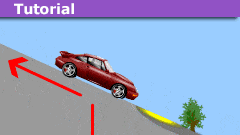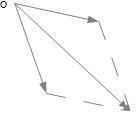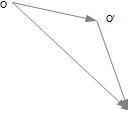Frequently Made Errors in Vectors – Elementary Use
Entire List for Frequently Made Errors Series
A vector has magnitude and direction. Pictorially, a vector can be imagined as a location in n-dimensional space relative to some fixed origin. The magnitude is represented by the distance from the origin to the point.
In Mechanics and Introductory Physics, we mostly deal with 2- and 3-dimensional vectors.
Some physical entities that behave as vectors are not completely characterized by their vectors. A force not only has magnitude and direction but also a point of application (a second vector). On the other hand, position, velocity, acceleration, and further time derivatives are each completely described by their vectors.
Table of Contents
1.Vector Addition
The addition of two vectors produces a resultant vector. There are two easy ways to picture this.
- We can draw a parallelogram using the two vectors as the sides adjacent to the origin. The diagonal from the origin is the resultant vector:
- We can take one vector as being from the origin O to a point O’, then rebase the other vector on O’, maintaining its magnitude and direction. This brings us to a new point. The line from O to this new point is the resultant vector:
“A force of 3.0 N and 1.0 N act on a 6.0 kg mass as shown. What is the acceleration of the 6.0 kg mass?”
Attempted answer:
X “I did 3N as ##f_{net}##, so ##f_{net}=ma##, 3=6a and solved for a“
The misunderstanding arises because, in the early examples students see, the applied forces are at right angles. Some come to assume that the resultant always looks like the hypotenuse of a right-angled triangle.
2.Notation: Vector Magnitudes and Unit Vectors
The magnitude (‘length’) of vector ##\vec v## is written ##|\vec v|##.
Sometimes we wish to represent only a direction. This is commonly done by constructing a unit vector, i.e. a vector with magnitude 1. Usually this is denoted with a hat symbol (circumflex) applied to the given vector symbol: ##\hat v = \frac{\vec v}{|\vec v|}##.
3. Scalar (Dot, Inner) Product
Given two vectors ##\vec v## and ##\vec w## in the same space, with angle ##\theta## between them at the origin, their scalar product is defined as ##\vec v.\vec w=|\vec v||\vec w|\cos(\theta)##. This is also known as their dot product or inner product.
Since the angle between a vector and itself is 0, ##|\vec v|^2=\vec v.\vec v##
It is common also to write ##\vec v^2## for ##\vec v.\vec v##.
Note that the dot product of two nonzero vectors is zero if and only if the vectors are perpendicular.
4. Vector Components and Resolution
It is frequently useful to resolve a vector into components.
A component of a vector ##\vec v## in a given direction is the extent to which the vector ‘goes’ in that direction. Most commonly, we wish to find the components of a vector in each of two perpendicular directions, which we shall here call X and Y, or denote with unit vectors ##\hat x## and ##\hat y##.
If the angle between ##\vec v## and ##\hat x## is ##\theta## then the magnitude of the component of ##\vec v## in the X direction is ##|\vec v|\cos(\theta)##.
We can also express this in terms of the dot product. The component of ##\vec v## in the X direction is ##(\vec v.\hat x)\hat x##, and in the Y direction is ##(\vec v.\hat y)\hat y##
This constitutes a resolution of the vector in the sense that the two components found can be added vectorially to regenerate the original vector:
##\vec v = (\vec v.\hat x)\hat x+(\vec v.\hat y)\hat y##
More generally, the component of ##\vec v## in the direction of some arbitrary vector ##\vec w## is ##\frac{\vec v.\vec w}{|\vec w|^2}\vec w##, or ##\frac{\vec v.\vec w}{\vec w.\vec w}\vec w##.
It is valid to find the components of a given vector in the directions of two vectors that are not perpendicular to each other. However, this does not constitute resolving the vector since the original vector is not the vector sum of those components.
The remaining topics all refer to vectors in three dimensions.
5. Vector (Cross) Product
In three dimensions, a vector product can also be defined. Given two vectors ##\vec v## and ##\vec w##, with angle ##\theta## between them at the origin, their cross product is a vector that is perpendicular to both and has magnitude ##|\vec v||\vec w|\sin(\theta)##. However, that does not serve as a definition since there are two such vectors (the one being equal and opposite to the other). To complete the definition, we apply a handedness rule. If the cross product is written as ##\vec v\times\vec w## then the order of the terms implies the direction of the result:
- Fold the third and fourth fingers (ring finger and little finger) of your right hand against the palm, keeping the index finger straight; the middle finger will be somewhere between the two angles;
- Point the thumb straight out to the side, away from the index finger;
- Align the index finger with the first vector in the product and the middle finger with the second;
- Your thumb is now pointing in the direction of the result.
Note that this means reversing the order of the arguments negates the result, ##\vec w\times \vec v=-\vec v\times\vec w##.
Geometrically, the magnitude of the cross product equals the area of the parallelogram formed by the two vectors.
Note that the cross product of two nonzero vectors is zero if and only if the vectors are parallel.
In particular, ##\vec v\times\vec v=0##.
We can write Pythagoras’ equation as ##\vec v^2 \vec w^2=(\vec v\times\vec w)^2+(\vec v.\vec w)^2##.
6. Scalar Triple Product
Since the vector product is a vector, we can take the dot product of that with a third vector. This turns out to be interesting since its magnitude is the volume of the parallelepiped defined by the three vectors. Thus, shuffling the three arguments around in the triple product only affects the sign: ##\vec a.(\vec b\times\vec c)=\vec b.(\vec c\times\vec a)=\vec c.(\vec a\times\vec b)=-\vec a.(\vec c\times\vec b)=## etc. If the cyclic order is preserved the sign is unchanged.
7. Vector Triple Product
If we consider ##\vec a\times(\vec b\times\vec c)##, the cross product executed first produces a vector at right angles to both ##\vec b## and ##\vec c##, and the later cross product produces a vector at right angles to that. It follows that the final result is in the plane containing ##\vec b## and ##\vec c##. Specifically,
##\vec a\times(\vec b\times\vec c)=(\vec a.\vec c)\vec b-(\vec a.\vec b)\vec c##
8. Solving Simultaneous Vector Equations
Given that ##\vec x \times \vec a=\vec b## and ##\vec x . \vec a=c##, and assuming ##\vec a \neq 0##, find ##\vec x##.
Of course, we could solve this by writing it out as three scalar simultaneous equations, but there is often an easier way.
If we take the vector product of the first equation with ##\vec a## we get
##\vec a \times \vec b=\vec a \times (\vec x \times \vec a)=(\vec a.\vec a)\vec x-(\vec a.\vec x)\vec a=\vec a^2\vec x-c\vec a##
So ##\vec x=\frac 1{\vec a^2}(\vec a \times \vec b+c\vec a)##.
Masters in Mathematics. Interests: climate change & renewable energy; travel; cycling, bushwalking; mathematical puzzles and paradoxes, Azed crosswords, bridge





Generally good insight as usual, but I feel I must nitpick a bit here, since you are mentioning the issue of vectors belonging to a position:
[QUOTE]Some physical entities that behave as vectors are not completely characterised by their vectors. A force not only has magnitude and direction but also a point of application (a second vector). On the other hand, position, velocity, acceleration, and further time derivatives are each completely described by their vectors.[/QUOTE]
While this may be true for the most basic use of vectors in terms of vectors in a Euclidean space, it is not generally true. For the more general vector concept, every vector is associated with a position and belongs to the tangent (or cotangent) space at that position.
Position is generally not a vector. Velocity belongs to the tangent space at the position of the object, as does acceleration. In a Euclidean space the position of the velocity vector may often be ignored as parallel transport is trivial, but consider movement on a sphere (such as the Earth’s surface) for example.
What an incredible resource this series has become!